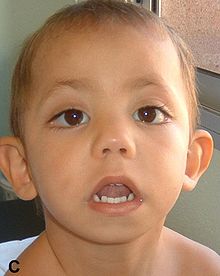Kabuki syndrome
This article includes a list of general references, but it lacks sufficient corresponding inline citations. (November 2008) |
| Kabuki syndrome | |
|---|---|
| Specialty | Medical genetics |
Kabuki syndrome, also previously known as Kabuki makeup syndrome, KMS or Niikawa–Kuroki Syndrome, is a pediatric congenital disorder of suspected genetic origin [1][2] with multiple congenital anomalies and intellectual disabilities. It is very rare, affecting roughly one in every 100,000 to 10,000,000 individuals. It was discovered and described in 1981 by two Japanese groups, led by the scientists Niikawa and Kuroki[1]. It is named Kabuki Syndrome because of the facial resemblance of affected individuals with white Kabuki makeup, a Japanese traditional theatrical form. On the Kabuki Syndrome listserv, children with this syndrome are called Kabuki Kids, or KKs.
Description
There is a wide range of congenital problems associated with Kabuki syndrome with large differences between affected individuals. Some of the common problems are heart defects (30%), urinary tract anomalies, hearing loss (50%), hypotonia, and postnatal growth deficiency (83%). Other characteristics include skeletal abnormality, joint laxity, short stature, and unusual dermatoglyphic patterns.[2] They often suffer from recurrent ear infections in infancy.
In terms of development, mild to moderate intellectual disability (92%) is a common feature. Also, children with Kabuki syndrome often have distinctive behavioural features. For example, 50% are described as unusually sociable, 30% as engaging in only minimal interaction with others, 74% as liking routine and 87% as having a happy disposition. A few have normal intelligence, most of whom have learning difficulties such as struggling with fine motor, speech skills, and having a good memory.
There is no indication that the life expectancy of individuals with Kabuki syndrome is shortened. Most medical issues are resolved with medical intervention. The fact that there are relatively few adults known with this syndrome is probably related to its recent discovery in 1980 in Japan and around 1990 in Europe and America.
Appearance

The facial appearance of individuals with this syndrome include long eyelids with turning up of the lateral third of the lower eyelid, a broad and depressed nasal tip, large prominent earlobes, and a cleft or high-arched palate.
Other clinical features often include scoliosis, short fifth finger, persistence of fingerpads, and X-ray abnormalities of the vertebrae, hands, and hip joints.
Causes
Inheritance is thought to be autosomal dominant or X-linked recessive; several chromosomal abnormalities have been found, but none of them appear to be specific to Kabuki Syndrome. In August 2010, a study[3][4] found that two thirds of the cases have a loss-of-function mutation in the MLL2 gene, which is coding for a histone methyltransferase; it can participate in epigenetic programming, and is thought to contribute to developmental processes.
Terminology
Several authors have recommended that the term 'make-up' be removed from the designation of this syndrome because some families considered the term objectionable.[5][6]
See also
References
- ^ Yoshikazu Kuroki, Yasuyuki Suzuki, Hiroyuki Chyo, Akira Hata, Ichiro Matsui (1981). "A new malformation syndrome of long palpebralfissures, large ears, depressed nasal tip, and skeletal anomalies associated with postnatal dwarfism and mental retardation". The Journal of Pediatrics. 99 (4): 570–573. doi:10.1016/S0022-3476(81)80256-9. PMID 7277097.
{{cite journal}}: Unknown parameter|month=ignored (help)CS1 maint: multiple names: authors list (link) - ^ den Biggelaar AM, Kuijpers-Jagtman AM, Bergé SJ, Katsaros C (2006). "Kabuki-syndroom, een congenitaal syndroom met multipele anomalieën (Kabuki syndrome, a congenital syndrome with multiple anomalies)" (PDF). Nederlands Tijdschrift Voor Tandheelkunde (in Dutch). 113 (12): 516–9. PMID 17193989. Retrieved 2009-05-07.
{{cite journal}}: Unknown parameter|month=ignored (help)CS1 maint: multiple names: authors list (link) CS1 maint: unrecognized language (link) - ^ Ng SB; Bigham AW; Buckingham KJ; Hannibal MC; McMillin MJ; Gildersleeve HI; et al. (2010). "Exome sequencing identifies MLL2 mutations as a cause of Kabuki syndrome". Nat Genet. 42 (9): 790–3. doi:10.1038/ng.646. PMC 2930028. PMID 20711175.
{{cite journal}}: Unknown parameter|author-separator=ignored (help) - ^ http://www.genomeweb.com/sequencing/exome-sequencing-study-yields-kabuki-syndrome-gene
- ^ Hughes HE, Davies SJ (1994). "Coarctation of the aorta in Kabuki syndrome". Archives of Disease in Childhood. 70 (6): 512–4. doi:10.1136/adc.70.6.512. PMC 1029872. PMID 8048822.
{{cite journal}}: Unknown parameter|month=ignored (help) - ^ Burke LW, Jones MC (1995). "Kabuki syndrome: underdiagnosed recognizable pattern in cleft palate patients". The Cleft Palate-craniofacial Journal. 32 (1): 77–84. doi:10.1597/1545-1569(1995)032<0077:KSURPI>2.3.CO;2. PMID 7727492.
{{cite journal}}: Unknown parameter|month=ignored (help)
External links
- GeneReviews/NCBI/NIH/UW entry on Kabuki syndrome, Kabuki Make-Up Syndrome, Niikawa-Kuroki Syndrome
- - Kabuki Stars, a UK-based support and information site
- The Australian Kabuki Syndrome Association - Supporting Australian Kabuki Families
- SAKKS.ORG (Supporting Aussie Kids with Kabuki Syndrome) - An Australian Kabuki syndrome support website
- GeneTests/NIH/NCBI/UW information on Kabuki syndrome gene testing
- ICD-9-CM Diagnosis 759.89 - Other specified congenital anomalies
- Kabuki Syndrome Network - An international Kabuki syndrome support website
